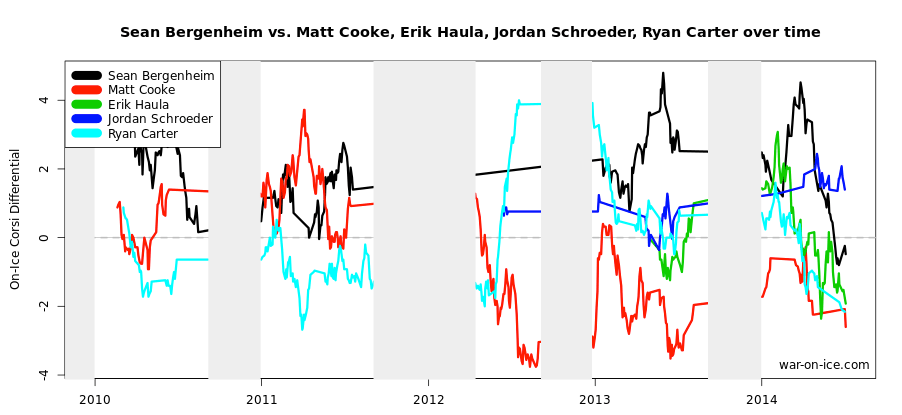One of the biggest (legitimate) knocks on Minnesota Wild coach Mike Yeo this season has been roster decisions. Knowing his history of roster decisions concerning players with strong possession numbers in the bottom two forward groups, many fans and analysts feared the worst from the Wild’s embarrassment of riches deep in the lineup. That’s why it came as a surprise that on Thursday when, in an interview on Twin Cities-based KFAN radio, Yeo announced that Sean Bergenheim was getting a start in Game 1.
Bergenheim: "These are the best games for a hockey player to play." #mnwild
— Minnesota Wild (@mnwild) April 16, 2015
It’s a bold move for a coach who has often valued short-term results in depth players and has cited plus/minus as a reason why a player (particularly, Nino Niederreiter) was buried in the lineup.
Bergen-history
Bergenheim has struggled in Minnesota since being acquired from the Florida Panthers a few days before the trade deadline, though he hasn’t been given a great opportunity to succeed. He saw just a couple games of top six minutes and quickly moved down the lineup after the production didn’t come right away. Ultimately, he was scratched for most of the last couple weeks of the season.
Through 17 games with the Wild, he has one goal, no assists, and an average of 1.4 shots per game. Part of acquiring him was certainly for his strong possession over recent seasons. Since coming to the Wild, we haven’t seen that. He’s got a 47.51% CF%, which is -2.19 CF%Rel. A big part of that? -13.18% ZSO%Rel. His 33.33% GF% (-33.97% GF%Rel) doesn’t look great either, but part of that is the small sample size and a 95.64 PDO.
However, a look at Own the Puck‘s usage-adjusted corsi might tell you that he should be given a slightly longer leash. His usage-adjusted corsi this season is 57%, the second time in his career he’s had a UA-Corsi of 57%.
The Decision
Part of the problem in not giving Bergenheim a little more space to find a rhythm is that deadline acquisitions have a tough job and coaches have a tough job in needing to make quick judgements on players who have little time to adapt.
For the player, they’re often leaving family, living in a hotel room, moving to a new city, and trying to learn a new system while playing in a heated part of the season where there’s little to no practice time. There’s also huge personal pressure. On top of having a spotlight cast on you, most traded players are in a contract year and we tend to evaluate for future expectations with an unfair weight on how they performed after being traded.
The team is in a tough spot too. They need results and quickly, because most teams trading for assistance are in need to due to injury or needing to win a lot of games down the stretch. That makes it hard to honor the process it takes to get the kind of results they’re looking for. It’s a shift in the team’s earlier mentality where they may been able to keep a player in a position to succeed while they struggle early in the season (see: Vanek, Thomas), but that’s a tougher decision to make during the stretch or in the postseason.
What Does It All Mean?
Small as a decision on who plays left wing on the fourth line may seem, it’s an encouraging statement from Yeo that he expects the Wild to play their style of hockey and not overreact to the Blues size and physicality.
Yes, Bergenheim has a strong history of performing well in the playoffs and that certainly plays into it. Yeo said as much during press time on Thursday.
However, the way Bergenheim plays in terms of possession and how that fits into the team’s system has to play a factor and that’s an encouraging sign. They didn’t default to looking for someone who can hold their own in a fight or looks to make a flashy open-ice hit to make a statement.
The Wild have many players to choose from for the fourth line. It looks like it will be Sean Bergenheim-Kyle Brodziak-Justin Fontaine. But there’s also Matt Cooke, Ryan Carter, Erik Haula, and Jordan Schroeder available.
Take a look at how Bergenheim’s possession numbers compare with a 25-game rolling average to the player’s he was chosen over through the last five seasons.
There’s a dip in Bergenheim’s numbers at the very end of the chart, but it’s improbable that a hard dip to the absolute bottom of variance for Bergenheim is the new normal. If he can play even at a career average, he’s likely to be a better possession player than the alternatives.
Statement or Reaction?
Unsurprisingly, Cooke was initially tapped to fill that role on the fourth line in Game 1. He’s the kind of utility-knife player that Yeo really likes. Cooke is seen as a player with offensive ability that can play up the lineup, he kills penalties, and brings physicality. Would he be my pick? No. But forced to choose again due to an injury to Cooke, Yeo is making a decision that could help the team if Bergenheim is able to get back to his style of hockey in Game 1.
Again, Bergenheim will be asked to perform above expectations in a small sample. Bergenheim’s leash will be short. Cooke isn’t ruled out for Game 2 and if Bergenheim falters Yeo has options. Schroeder brings speed and scoring, Haula is an excellent penalty killer and was able to shadow top offensive talents in the playoffs with success last year, and Carter is a physical player who Yeo could turn to if he thinks the Blues are bullying the Wild.
But the ball is Bergenheim’s court and Yeo is giving the team their best shot at taking control of the series early on.
